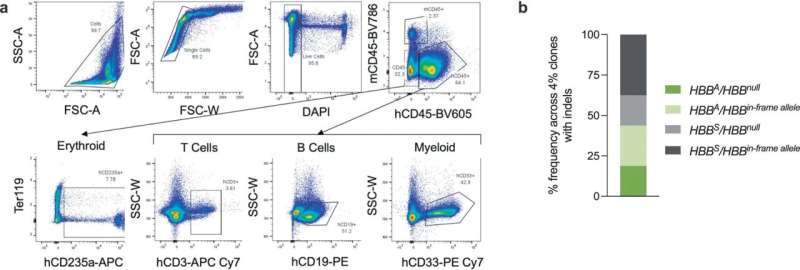Prime editing shows proof of concept for treating sickle cell disease


Sickle cell disease (SCD) is a serious blood disorder affecting millions of people, primarily those of African descent. A mutation in the gene that encodes a subunit of the oxygen-carrying molecule, hemoglobin, causes the disease.
Scientists at St. Jude Children’s Research Hospital and the Broad Institute of MIT and Harvard showed a precise genome editing approach, prime editing, can change mutated hemoglobin genes back to their normal form in SCD patient cells, which restores normal blood parameters after transplantation into mice. The findings were published today in Nature Biomedical Engineering.
Scientists have rapidly developed technologies to edit DNA, including Cas9 nucleases and base editors, to treat genetic diseases. The study’s researchers demonstrated how a “third-generation” programmable gene editing technology called prime editing could convert the mutation that causes SCD into the normal DNA sequence, thereby rescuing the disease.
“Prime editing is a promising approach because, in theory, we can directly correct disease mutations to specific healthy DNA sequences of our choosing,” said co-corresponding author Jonathan Yen, Ph.D., St. Jude Department of Hematology. “We optimized prime editing in long-term blood stem cells and showed that the prime editing cells maintain full engraftment efficiency in an animal with a clinically relevant system.”
“These results show efficient prime editing of blood stem cells and that the prime-edited cells maintain their full ability to engraft and repopulate the bone marrow of an animal,” said senior and co-corresponding author David Liu, Ph.D., Richard Merkin, Professor at Broad Institute of MIT and Harvard, whose lab invented prime editing in 2019. “Bringing the ‘search-and-replace’ versatility of prime editing to blood stem cells raises the possibility of applying this technology to treat a wide range of diseases involving blood cells.”
Fixing the mutation that causes sickle cell disease
The researchers showed that the prime editing system could find the disease-causing mutation in the adult hemoglobin gene with high specificity and replace it efficiently with the healthy DNA sequence variant carried by most humans. Prime editing successfully corrected this mutation with up to 41% conversion in blood stem cells from SCD patients. Previous research has shown that editing over 20% of cells likely translates to therapeutic benefit.
Adding to the approach’s therapeutic promise is the observation that when the researchers transplanted prime-edited cells from four SCD patients into mice, normal hemoglobin production was present in about 45% of circulating red blood cells, even up to 17 weeks later. After the transplant, when placed in low-oxygen environments, the red blood cells isolated from the mouse bone marrow reduced sickling by half, from about 67% to 37%.
Improving precision gene editing
“We have identified what might be the next wave of therapies for genetic anemias,” said co-author Mitchell Weiss, M.D., Ph.D., St. Jude Department of Hematology chair. “We took the newest cutting-edge genetic engineering technology and showed that we could make meaningful gene edits for future therapies.”
While the scientists conducted the research in SCD patient cells transplanted into mice, the approach may have advantages over current genome editing methods used in clinical trials, such as Cas9 nucleases, which make double-stranded breaks in DNA that prime editing largely avoids. The collaborators had previously shown base editing, an alternative genome editing technology, could turn the sickle cell mutation into a benign variant, but not the original healthy sequence, in a 2021 Nature publication. The current study showed prime editing could turn the disease mutation into the original normal gene variant through a T-to-A conversion, which base editing cannot make.
Though the study showed the potential benefits of using prime editing to cure genetic anemias, it also showed limitations. Prime editing requires a time-consuming process to adapt and optimize each step of the protocol, such as designing the prime editing guide RNAs (pegRNAs) that target the prime editing system to the right DNA region and specify the desired edit.
Safety first
Safety remains a concern for all genomic editing technologies, especially novel approaches. While the current study, consistent with other labs’ reports on prime editing, showed virtually no off-target prime editing, it could have unforeseen safety issues as a newer gene editing technology.
“We are doing our best to predict toxicity, but we won’t know the true extent of the risks of this therapy until it is used in patients,” said Weiss.
Even with these challenges, the scientists are optimistic about the future of prime editing.
“Because of its unique versatility, prime editing has the potential to cure many more genetic diseases,” Yen said. “It will be a challenge to get to the clinic. It will require extensive manufacturing development, process optimization and safety assessment. But the proof of concept is there. Our work now opens the door to developing cures for many hematological diseases.”
More information:
Jonathan Yen, Ex vivo prime editing of patient haematopoietic stem cells rescues sickle-cell disease phenotypes after engraftment in mice, Nature Biomedical Engineering (2023). DOI: 10.1038/s41551-023-01026-0. www.nature.com/articles/s41551-023-01026-0
Journal information:
Nature Biomedical Engineering
,
Nature
Source: Read Full Article